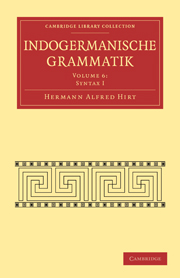VI - Infinitiv und Partizipium
Published online by Cambridge University Press: 05 August 2011
Summary
Vorbemerkungen.) Der Infinitiv wird von den alten Grammatikern zum Verbum und insbesondere zu den Modi gerechnet. Der lat. Ausdruck übersetzt das gr. ἀπαρέμφατoς ἔγκλισις, d. i. ein Modus, der die Personen nicht mit bezeichnet, der unbestimmt ist.
Die Alten sind nicht zu einer klaren Erkenntnis dessen gekommen, was eigentlich ein Infinitiv ist. Erst Fr. Bopp hat in ihm die erstarrte Form eines Nomen, eines sog. Verbalabstraktums gesehen, und diese Ansicht ist heute über jeden Zweifel erhaben. Ein Nomen nimmt aber entweder gar nicht oder nur zu einem geringen Grade am Genus Verbi und am Tempus teil, und diesen Stand der Dinge finden wir im Germanischen, Litu-Slawischen und vor allem im Indischen noeh erhalten.
Das Griechische und Lateinische sind andere Wege gegangen. Hier haben wir nicht nur aktive und mediopassive Infinitive, sondern auch solche des Präsens, des Futurs, des Aorists und des Perfekts. Hier ist also der Infinitiv in weit höherem Maße in das Verbalsystem eingegliedert als in den genannten Sprachen.
Im Lateinischen haben wir neben dem Infinitiv noch eine andere Form, die dem Infinitiv der andern Sprachen genauer entspricht, weil sie nicht von einem Tempusstamm gebildet ist, das Supinum auf -tum amātum und auf -tū audītu. Allerdings ist auch hier das Genus Verbi eingeführt, indem das erstere aktivische, das zweite passive Bedeutung hat, aber am Tempus nimmt das Supinum nicht teil.
An und für sich ist es besser, für den sog. Inf. der Sprachen, außer Griechisch und Lateinisch, den Ausdruck Supinum einzuführen.
- Type
- Chapter
- Information
- Indogermanische Grammatik , pp. 181 - 197Publisher: Cambridge University PressPrint publication year: 2009First published in: 1934



